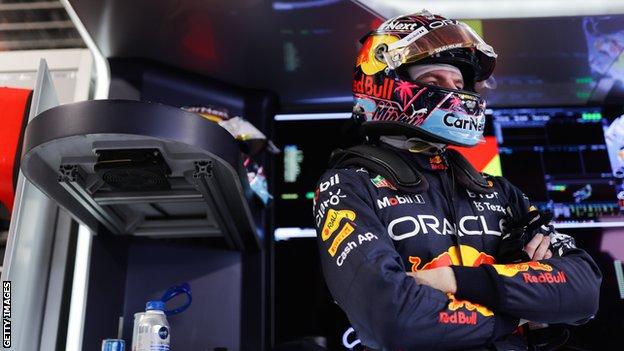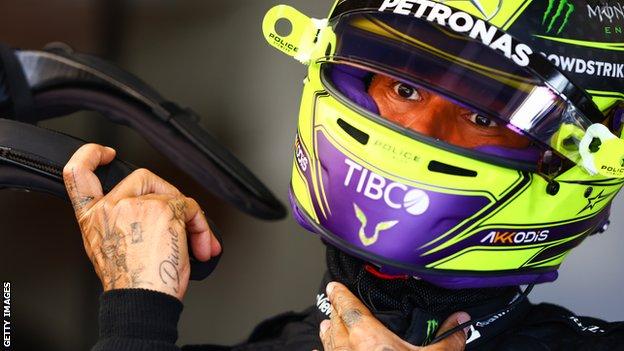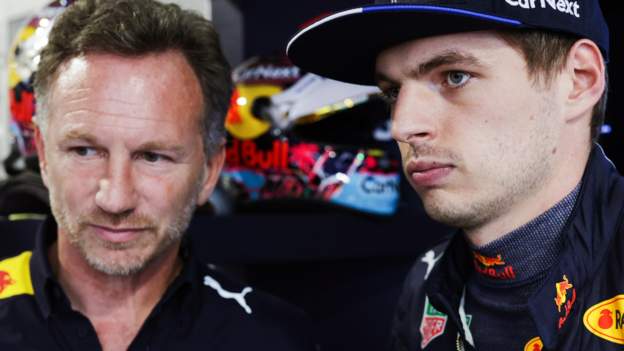
Max Verstappen criticised his Red Bull team’s reliability struggles after qualifying at the Miami Grand Prix, saying that they were harming their hopes of defending his world championship.
The Dutchman lost out on pole position at the Florida city’s inaugural race after an error on his final qualifying lap – which he blamed on his lack of knowledge of the car on this track caused by a messy Friday on which he managed very few laps.
The mistake not only gave title rival Charles Leclerc the opportunity to jump ahead of Verstappen, but let in his Ferrari team-mate Carlos Sainz, too, to seal a Ferrari front row for Sunday’s race.
The world champion now has two red cars to beat on Sunday, not just one, which has been the case so far this year.
“I have only done four or five laps yesterday and you cannot afford that on a new track, and a street circuit in general,” Verstappen said, “because it is very critical to do laps and understand the car.
“On a normal track, it is quite easy to get in a rhythm but on a street circuit it is a lot more difficult and we basically failed on that side.”
Verstappen said the weekend had been “incredibly messy and we just make it super-difficult for ourselves”.
What went wrong for Verstappen?
Friday was indeed a difficult day for Verstappen and Red Bull. Overheating problems in the first practice session limited his running, and caused sufficient damage to require the gearbox to be changed.
That meant Verstappen was late out for the second session, and on his first lap the car simply wasn’t working. A hydraulic leak affected the car’s systems, causing heavy steering and leading to a fire in a rear brake. That was the end of his day.
Verstappen hit the ground running on Saturday morning, immediately on the pace. But the knock-on effects lasted well into qualifying.
“You start today still learning the track, trying to find a set-up because yesterday you had no clue what worked because we had not a lot of data to look at,” he said.
“Of course we are experienced (enough) to catch up a lot of it, but to really fight against a strong team like that, we cannot afford it. We still got close but we could have done a much better job today if we had a cleaner Friday.
“Up until a certain point, it was fine, but to really go to the limit and try to find more time, in Q3 I was still figuring out a lot of things in terms of braking and brake shapes and all these kinds of things to try and be faster.”
His supreme natural talent meant he was still able to be quickest on the first runs in final qualifying. But Leclerc and Sainz were close behind and he knew they would improve. Pushing harder, he took things too far and lost the car at Turn Five.
He said it was “a weird moment to lose the car” but blamed it on “not really knowing the limits”.
The context for Verstappen’s comments is a start of the season in which he has failed to finish in two of the first four races, costing him a massive 36 points to Leclerc.
Two different problems with the fuel system forced him to retire from second place within sight of the finish in the opening race in Bahrain, and about halfway through the race in Australia.
The error Leclerc made while trying to chase down Verstappen’s team-mate Sergio Perez for second place at Imola last time out allowed the Dutchman to claw back seven more points than he already would have had Leclerc finished third rather than sixth.
But Verstappen still trails his rival by 27 points heading into the race, a margin he knows will not be easy to overhaul, and is clearly uncomfortable as to whether his team is fully on top of the operation of its car at this stage of the season.
Delight with Miami, unhappiness with the FIA
So far, the Miami race has been a massive hit. F1’s owners Liberty Media have wanted a grand prix here since they took over the sport in 2017. This is not their ideal, but plans for a street circuit downtown that took in one of the bridges over Biscayne Bay towards Miami Beach had to be dropped in the face of local opposition.
Considering the alternative is a track built solely on land around an NFL stadium, it is an impressive facility. The city has really taken to F1. Tickets sold out immediately when they went on sale. The paddock has been crammed all weekend, and many of the fans who made it in are celebrities.
Former First Lady Michelle Obama topped the pile of dignitaries on Saturday, which included comedian James Corden, and on Sunday many more are promised, including basketball legends Michael Jordan and Lebron James, Hollywood stars Dwayne ‘The Rock’ Johnson and Renee Zellweger, and pop stars Wyclef Jean and Pharell Williams.
The place is properly buzzing and the drivers all like the circuit, with the exception of the fiddly, slow-speed section towards the end of the second sector.
Their concerns about that part at the start of the weekend were that it would ruin the flow of the track, and those remain. But a bigger issue emerged over the weekend – safety.
Sainz crashed there on Friday and did a lot of damage to his Ferrari, despite the low speeds involved, because there was no impact-absorbing barrier there, only a concrete wall.
On Friday evening, at drivers’ briefing with race director Niels Wittich, Sainz was very clear that he thought a barrier was needed but his pleas were ignored.
Shortly after the start of final practice on Saturday, Alpine’s Esteban Ocon had an almost identical accident, and again recorded a heavy impact. It broke his car’s chassis, and that forced him to miss qualifying. The drivers were unimpressed.
“I’m sorry to be critical,” Sainz said, “but I told the FIA yesterday that my crash at second gear shouldn’t feel that hard. But today, my neck was a bit in pain and I told them: ‘Let’s put Techpro (barrier) there because it’s a very hard concrete wall.’
“Esteban crashed and I’m pretty sure he felt it too and it’s one of those things I will never understand.”
Ocon himself said: “What’s unacceptable really is that it was 51G for what should have been not such a big impact.
“I hurt my knees. That’s the biggest thing. I was not expecting it to be that bad. Would there have been Techpro, probably the chassis would have been fine.
“Carlos said the impact was way too big, and today it felt huge. It’s probably the biggest shunt of my career to be fair. So yesterday Carlos got hurt, today I got hurt as well. FIA should push harder for our safety.
“When a professional driver of the calibre of Carlos, driving for Ferrari, says something like this yesterday I think the minimum is that it should be taken into consideration and do the best possible to make a change.”
The FIA said that the corner was not deemed a priority for a barrier before the weekend because it was not a safety concern – and they continue to stand by that position.

Safety and the row over jewellery and underwear
The irony of this is that the FIA has been making a big deal about safety recently in another area, also to controversial effect.
Wittich has taken a hard line on the rules forbidding drivers to wear jewellery in the car, and it came to a head this weekend when Lewis Hamilton was forced to take out his earrings before being able to drive.
This came after a meeting between Mercedes F1 boss Toto Wolff and FIA president Mohammed Ben Sulayem on Friday morning, after Hamilton had said in the official news conference that the stance being taken was “unnecessary”.
“I am willing to sign a waiver to take the responsibility away from them if necessary,” the seven-time champion said. “It is about individuality and being who you are.”
Hamilton was backed by a number of fellow drivers.
Pierre Gasly said that, as a religious man, he would be uncomfortable not taking some of the religious artefacts he wears into the car with him.
Sebastian Vettel, in protest against a ruling that drivers cannot wear their own underwear because it is not fireproof, wandered around the paddock on Friday wearing his boxer shorts over his race suit.
Kevin Magnussen said that if he had a serious crash, he would not want to not be wearing his wedding ring.
As it happens, wedding rings are exempt from the ruling because they are not explicitly mentioned in the rules. So is a bracelet Fernando Alonso wears, because of the material it is made of. But Hamilton’s nose ring, which he says he cannot take out, is not.
He has been given a two-race exemption for it, but said on Saturday he has no intention of removing it for Monaco.
“I got an exemption here,” he said. “I’ll get an exemption for the rest of them. Wedding rings are allowed.”
“This whole safety thing, man,” Hamilton added. “When they told me about the jewellery, they say safety is everything. Well, what’s happened the last 16 years? I’ve had jewellery on for 16 years, was safety not an issue back then?”
And he drew a direct line between the contrasting stance of the FIA on the two issues.
“When we come to these new tracks they do their best job,” Hamilton said. “I think they’ve done a great job with all these new tracks with safety. You can’t predict every single corner where we’re going to need Techpro. I think after an experience like this weekend we can learn that’s an area to improve on. That’s a part of the lessons we learn.”
Why does this all matter?
Some may think the jewellery and underwear row is a bit of a storm in a teacup, perhaps even a little petty. Some will support the FIA’s stance; some the drivers’.
But there is a bigger picture here; and it is to do with the satisfaction of the teams and drivers with the FIA in general. Or the lack of it.
Wolff has wondered aloud whether Wittich really needs to pick that fight, but Wittich is just the middle man. The push is coming from Ben Sulayem.
It’s not just the drivers’ noses that are being put out of joint by the FIA at the moment. Last month, Ben Sulayem refused to agree to plans to double the number of ‘sprint’ events next year to six.
The reason given publicly for this was that he wanted more time to study the impact of the plan on the FIA’s race weekend resources.
Teams are briefing that in fact the reason is money – Ben Sulayem asked for more to be paid to the FIA in return for his agreement. Despite the fact that as the teams pay their entry fees based on the number of points they earn, and the number of points for sprints has been increased this year, they would get more money for more sprint races anyway.
This has angered the teams and bosses of commercial rights holder F1, and it has added to a range of issues that are causing dissatisfaction with the FIA’s actions in recent months.
Insiders have told BBC Sport that senior F1 figures are actively questioning whether they need the FIA involved in the the sport, and are looking at ways in which they could be removed from being so.
Much of the FIA’s income comes from F1, but it spends a relatively small amount of it on the highest level of the sport. In other words, the FIA needs F1 much more than F1 needs the FIA. Or so at least some senior figures are saying.
Could the FIA end up being removed from any effective role in the running of its blue-riband category and be relegated to a largely ceremonial function?
If so, it would be a seismic moment in the governance and history of F1. It may not get that far. But this, it is said by a number of sources, is not an issue that is going away any time soon.

